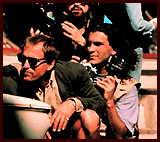On the subject of lighting, Hobson says, "I generally concern myself with color contrast in the frame. One non-variable light source, such as a practical, usually determines the gel setup and often the type of lamps used. For one sequence, where we see the light from distant shelling illuminating a face through a window, I used a 500 watt Mizar bounced by hand from outside the set. Again I kept the light levels painfully low and shot wide open."
The real life journalists who gathered nightly at the Holiday Inn bar devised makeshift implements for basic lighting just in order to see such as hanging battery-driven car headlights from the ceiling. The filmmakers followed suit. "We used actual practicals, supplied by production designer Mark Gheraty," says Hobson. "These included old headlights and brakelights, along with oil lamps and flashlights and the occasional Kino in shot. It wasn't easy, working in an almost entirely black market economy. Gheraty did a stunning job, especially in finding authentic materials locally."
Small KinoFlos were placed inside the eight- and nine-inch long flashlights which were part of every correspondent's survival kit. Hobson then bounced another two-foot Kino off the ceiling or wall to add a bit of ambiance "that level of low, low ambiance that makes you feel ill to the bottom of your spot meter," he laughs.
Even during the day very little light penetrated buildings, as most windows were at least partially covered with sheets of plastic or sandbags, to provide protection during attacks. Hobson positioned HMIs outside the semi-blocked windows to suggest light struggling to penetrate the cracks. (Most of the lighting equipment was Arriflex, with odd bits of Balancroft and Sirio HMIs. All the gear came from Arri Bell in London.)
Likewise, 6k Pars were set up outside the orphanage's basement windows, casting a bright, hot daylight through the windows that quickly fell off, leaving the rest of the room in relative darkness.
Due to the extremely low light conditions dictated by the story Hobson, shot the bulk of the picture on Kodak 5297. For the rest he used Kodak 5293, a stock he has long favored. "I loved it from the first time I used it. It has been out seven or eight years now and I feel I am still learning. It is very colorful, with rich blues and reds, and has a good contrast."
Hobson also likes a shallow depth of field, explaining, "A subject which is sharply in focus is complimented by a background that is out of focus. I like to work at wide open stops, as wide as possible, but rarely will I go to a slower speed stock to try and achieve a shallower depth of field. Rather than give up 93 I'll pile NDs on the front of the lens to open it up."
As a cinematographer who operates as well as lights, Hobson says his main decisions are made by eye through the viewfinder. Slyly, he adds, "I'm sure a lot of operating cinematographers will quietly admit they take light meter readings just to make everybody on set think that they are actually earning their money. I may take a few specific readings and roughly calculate the ND that I want to put on, and I'll put it on and my eye will say, 'oh, that's a bit too much,' so I'll take one back. If I'm outside I will automatically shoot with an N9. It's on all the time."
Hobson's choice of lenses also reflects his preference for a shallower depth of field. On Welcome to Sarajevo he stayed in the 35mm to 135mm range, working chiefly with 65mm, 85mm, 100mm and 135mm lenses. He also took a Leitz 180, a Nikon 400 and a Taylor-Hobson 10-to-1 zoom, which he used only for bright exterior day and second unit general views.
His camera package in the Balkans consisted of two Moviecam Compacts, one of which doubled for the Steadicam. (About 20 percent of the picture was shot with a Steadicam; operator Vince McGahon also manned the B-camera.) Hobson generally dislikes using multiple cameras, saying it compromises lighting and, at times, camera angles.
Welcome to Sarajevo proved an unusually emotional experience for Hobson, who watched as local residents, hired as movie extras, relived the horrors of their recent past. "When the Chetniks (Serb paramilitary soldiers) get on the bus (and start pulling children off), the kids and mothers were actually crying during each take. It brought it all back to them. I cried shooting it."
"The biggest issue for me working on this film was: what would I have done if I had been living there during the war? The long-haired art student who was helping us in the camera department had spent four years firing a rifle. What would I have done? Would I have left the country? Would I also kill? I was that same long-haired art student once."
